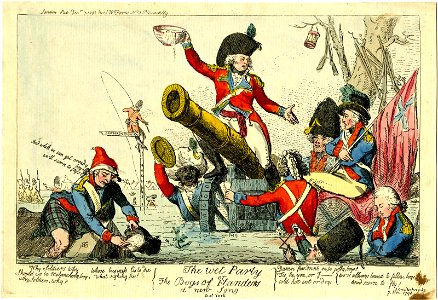Officers and men of the british army are waist-deep in water. The central figure is the duke of york astride a gun whose carriage is half immersed. He holds up a punch-bowl, singing and looking down at a party, half submerged, of officers (right). The black cymbal-player (see bmsat 8327) stands beside the gun (left) shouting with upraised cymbal. An officer in back view holds out a glass. Another seated on (?) a gun-carriage holds a british flag. An officer (right) sleeps with folded arms. A man whose head only emerges plays a triangle. Muskets and a drum hang from the branches of a tree (right). On the left a highlander, astride a submerged tent, dips his hat into the water, singing:
"and while we can get brandy boys we'll scorn to fly!"
in the distance (left) a soldier perched on a high sign-post inscribed 'best road to dunkirk' wields a fishing-rod, the line in the mouth of a soldier whose head and shoulders emerge from the water. Other small figures and half-submerged tents (left) complete the design. Beneath the title: 'a new song'. The words beneath the design are:
'why soldiers why
should we be melancholy, boy;
why, soldiers, why?
whose business 'tis to die
what sighing fie!
damn fear, drink on, be jolly, boys!
'tis he, you or i -
cold hot wet & dry;
we're allways bound to follow, boys, annd scorn to fly!' 7 december 1793. Hand-coloured etching. Date: 1793. Dimensions: Height: 242 mm; Width: 358 mm. Medium: paper. Depicted People: Frederick Augustus, Duke of York and Albany and Bishop of Osnabrück, . Collection: British Museum. The wet party or the bogs of Flanders (BM 1868,0808.6316)
Loading...
